
In musical instrument classification, string instruments or chordophones, are musical instruments that produce sound from vibrating strings when a performer plays or sounds the strings in some manner.

Zithers are a class of stringed instruments. Historically, it could be any instrument of the psaltery family. In modern terminology, it is more specifically an instrument consisting of many strings stretched across a thin, flat body, the topic of this article.

The bouzouki is a musical instrument popular in Greece. It is a member of the long-necked lute family, with a round body with a flat top and a long neck with a fretted fingerboard. It has steel strings and is played with a plectrum producing a sharp metallic sound, reminiscent of a mandolin but pitched lower. It is the precursor to the Irish bouzouki, an instrument derived from the Greek bouzouki that is popular in Celtic, English, and North American folk music. There are two main types of Greek bouzouki: the trichordo (three-course) has three pairs of strings and the tetrachordo (four-course) has four pairs of strings. The instrument was brought to Greece in the early 1900s by Greek refugees from Anatolia, and quickly became the central instrument to the rebetiko genre and its music branches. It is now an important element of modern Laïko pop Greek music.

An autoharp or chord zither is a string instrument belonging to the zither family. It uses a series of bars individually configured to mute all strings other than those needed for the intended chord. The term autoharp was once a trademark of the Oscar Schmidt company, but has become a generic designation for all such instruments, regardless of manufacturer.

A psaltery is a fretboard-less box zither and is considered the archetype of the zither and dulcimer. Plucked keyboard instruments such as the harpsichord were also inspired by it. Its resonance box is usually trapezoidal, rectangular or in the form of a "pig's head" and often richly decorated.

Gusli is the oldest East Slavic multi-string plucked instrument, belonging to the zither family, due to its strings being parallel to its resonance board. Its roots lie in Veliky Novgorod in Novgorodian Republic. It has its relatives in Europe and throughout the world: kantele in Finland, kannel in Estonia, kanklės in Lithuania, kokles in Latvia, Zither in Germany, citera in the Czech Republic, and psalterium in France. Furthermore, the kanun has been found in Arabic countries, and the autoharp, in the United States. It is also related to such ancient instruments as Chinese gu zheng, which has a thousand-year history, and its Japanese relative koto. A stringed musical instrument called guslim is listed as one of the Me in ancient Sumer.

The Appalachian dulcimer is a fretted string instrument of the zither family, typically with three or four strings, originally played in the Appalachian region of the United States. The body extends the length of the fingerboard, and its fretting is generally diatonic.

The swarmandal, surmandal, or Indian harp is a plucked box zither, originating from India, similar to the qanun that is today most commonly used as an accompanying instrument for vocal Indian classical music. It is part of the culture of Northern India and is used in concerts to accompany vocal music. The name combines Sanskrit words svara (notes) and maṇḍala (circle), representing its ability to produce many notes. The instrument was seen as equivalent by the Ā'īn-i-akbarī to the qanun.

The Marxophone is a fretless zither played via a system of metal hammers. It features two octaves of double melody strings in the key of C major, and four sets of chord strings. Sounding somewhat like a mandolin, the Marxophone's timbre is also reminiscent of various types of hammered dulcimers.

The bowed psaltery is a type of psaltery or zither that is played with a bow. In contrast with the centuries-old plucked psaltery, the bowed psaltery appears to be a 20th-century invention.

The ukelin is a stringed musical instrument made popular in the United States in the 1920s. It is a bowed psaltery with zither strings, and its name derives from the ukulele and the violin. It lost popularity prior to the 1970s because the instrument was difficult to play and often returned to the manufacturer before it was completely paid for.
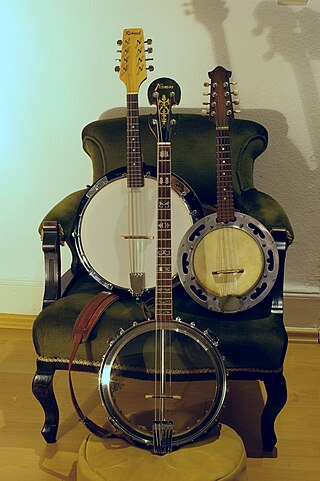
The mandolin-banjo is a hybrid instrument, combining a banjo body with the neck and tuning of a mandolin. It is a soprano banjo. It has been independently invented in more than one country, variously being called mandolin-banjo,banjo-mandolin,banjolin and banjourine in English-speaking countries, banjoline and bandoline in France, and the Cümbüş in Turkey.
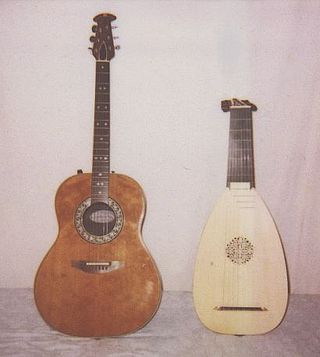
Plucked string instruments are a subcategory of string instruments that are played by plucking the strings. Plucking is a way of pulling and releasing the string in such a way as to give it an impulse that causes the string to vibrate. Plucking can be done with either a finger or a plectrum.
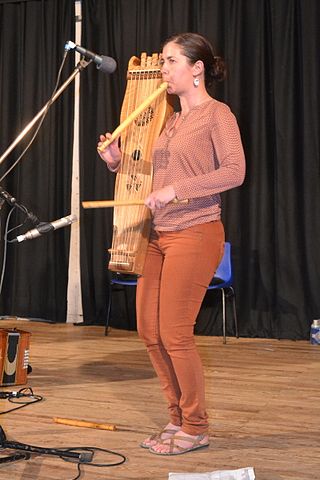
The string drum or Tambourin de Béarn is a long rectangular box zither beaten with a mallet. It is paired with a one-handed flute with three finger holes, similar to a pipe and tabor. It has also been called tambourin de Gascogne, tambourin à cordes in Catalan, Pyrenean string drum, ttun-ttun in Basque, salmo in Spanish, and chicotén in Aragonese. It was known in the middle ages as the choron or chorus.

Oscar Schmidt was a musical instrument manufacturing company established in 1871. During its long existence, Oscar Schmidt has produced a wide range of string instruments, not only guitars but also numerous models of parlour instruments such as autoharps, celtic harps, guitar zithers, the "guitarophone", marxophones and bowed psalteries.
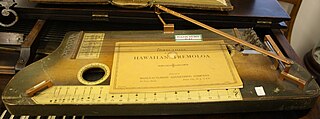
The tremoloa, plural tremoloas, is a stringed instrument belonging to the fretless zither family. It was produced in United States in response to the rapid increase in popularity of Hawaiian music during the 1920s, and continued to be produced until the 1950s. Musical collective Broken Social Scene features the instrument in "Tremoloa Debut." The instrument is also featured sporadically on The Magnetic Fields' album 69 Love Songs.

The veena, also spelled vina, is any of various chordophone instruments from the Indian subcontinent. Ancient musical instruments evolved into many variations, such as lutes, zithers and arched harps. The many regional designs have different names such as the Rudra veena, the Saraswati veena, the Vichitra veena and others.
The Phonoharp Company (1892–1928) was an American manufacturer of musical instruments based in Boston, Massachusetts. Among the instruments the company was known for was the autoharp, whose design they acquired from Alfred Dolge in 1910; they later merged with Oscar Schmidt in 1926. The company was also known for producing other instruments, namely the guitar zither, mandolin zither, celestaphone, and the ukelin.
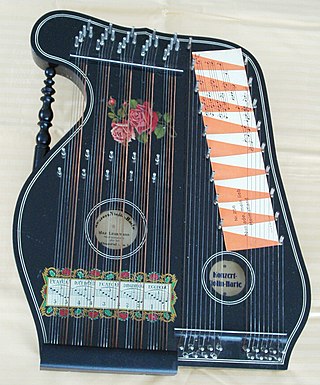
The Violinzither or Violinharp is a string instrument of the zither family, invented in 1925 by Clemens Neuber in Klingenthal. The instrument is a cross between the fretless chord zither and a concert zither.


















